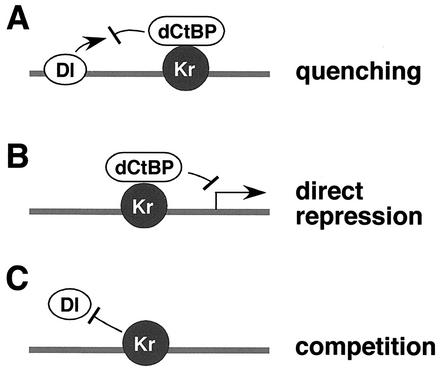FIG. 6.
Role of dCtBP in the three major modes of repression. There are at least three distinct mechanisms of transcriptional repression (for a review, see reference 7): quenching, direct repression, and competition. We demonstrated that quenching and direct repression require dCtBP, while repression by competition is dCtBP independent. (A) Repression by quenching. Repressors and activators bind to adjacent sites, and then the repressor inhibits the function of the neighboring activators. dCtBP is required for the quenching activities of three short-range repressors: Krüppel, Knirps, and Snail (21). The Dorsal (Dl) activator is inhibited by a complex of the short-range Krüppel repressor (Kr) and dCtBP when Dorsal binding sites are within 100 bp of the Krüppel binding sites. (B) Direct repression of the core promoter. A repressor binds within 100 bp from the transcription start site and directly blocks promoter activity. Krüppel (Kr) and Knirps, along with dCtBP, can mediate direct repression when bound near the promoter. (C) Repression by competition. Activators and repressors can compete for a common binding site. We created an artificial enhancer containing overlapping Bicoid, Dorsal, and Krüppel binding sites. Krüppel and Dorsal proteins compete for binding to DNA in vitro and in vivo. In the absence of dCtBP, Krüppel continues to compete with Dorsal and to repress the reporter gene. Moreover the Krüppel DNA-binding domain is sufficient to mediate repression in cultured mbn-2 cells.

